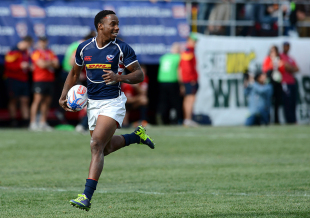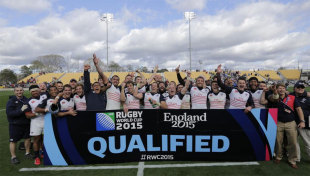|
Craig Dowd
USA - the last rugby frontier
Craig Dowd
October 29, 2014

Sonny Bill Williams and the All Blacks go unnoticed in Chicago © Getty Images
Enlarge
Thinking about the weekend Test between the All Blacks and the United States Eagles at Soldier Field got me thinking about the missing links in professional rugby. The occasion in Chicago will be exciting and a great showcase for the All Blacks' skills, but I hope somewhere in the mix the Eagles players get to demonstrate some of their wares so the home public go home satisfied with what they see. In looking at the playing of the match, I couldn't help thinking back to the dawn of the professional game in 1995. I remember after the Bledisloe Cup game played in Sydney after the Rugby World Cup of that year, being bundled on a bus and taken to a location where all the All Blacks met in a darkened room and heard a proposal for our professional futures. This was the Kerry Packer-backed bid to secure the professional game, and there were three key players in the picture: Europe, the Southern Hemisphere and the United States. The first two have come to fruition under the traditional rugby model, but the third hasn't; given the All Blacks are playing in Chicago at the weekend, we can only wonder about the ripple effects of their appearance. So far as the All Blacks are concerned, they are playing a game to showcase rugby to Americans; it is also a chance to give the coffers of New Zealand Rugby a much-needed boost. And with that in mind it was interesting to learn that a National Rugby Football League has been developed in the United States based in Minneapolis-Saint Paul, and that they are holding a 'combine' from January 12-15 next year at the Los Angeles Memorial Coliseum to evaluate talent for teams to play in their competition, possibly as early as the northern hemisphere summer of 2015.

Once an NFL player, Carlin Isles has become one of the biggest names in Rugby 7s
© Getty Images
Enlarge
The founder of the NRFL, Michael A. Clements, said the assessment process would be of benefit to American Football athletes who had been released by their professional teams, along with those who played collegiate football. Clements said there was so much elite football talent in the US that it would be a shame not to utilise it. "In fact, with this talent we can create a competitive major league right now," he was quoted as saying. The NRFL have already been contacting players after roster reductions by the NFL franchises. A combine held in April this year attracted interest from 12 European club sides, and the move to the Los Angeles Coliseum has been made to accommodate more competitors than the 180 who took part in April. Clements said the league officials were aware that more than 20 million Americans had expressed an interest in rugby, and there were 450,000 amateur players in the US with the number growing at a rate of 20% a year. It can only be wondered what might be the outcome if this sleeping giant awakens. The American sports market is easily the largest financial sports market in the world, and some of the details are interesting. Each year, more than US$11 billion (£6bn) is spent in sports sponsorship; US$26bn (£16bn) is spent on national television advertising for sport; fans spend US$13bn (£8bn) a year attending games; and merchandising and the like total US$14bn (£8.7bn); the total spend is $US65 billion per year. If rugby were able to get a foothold, it would be at the lower end of the market in terms of costs with a quality world-class rugby squad anticipated to cost $US5.3 million. But the opportunity to play in these squads has immediate implications for New Zealand players as another venue in which to play the game.

The USA Eagles celebrate qualifying for the 2015 Rugby World Cup
© Twitter
Enlarge
Questions that have to be asked are whether the International Rugby Board is prepared to back the competition; and what are the prospective effects on the four Sanzar nations of New Zealand, South Africa, Australia and Argentina, and also the European rugby clubs? When you think of all the under-utilised American Football stadiums in the US, one would think there should be no issue getting access to grounds; there should also be the ability to secure television coverage of the league. So while the All Blacks are waving the rugby flag in Chicago, they may also be giving a sizeable boost to athletes in the US who having been frustrated in failing to make the cut with their franchises and schools, and help them to find a lifeline to let them utilise their talents. It may be that the development of US rugby is about to take a significant step albeit aided unknowingly by the All Blacks. We will never know what would have been had the players decided to go with the Packer proposal back in 1995, when the Sanzar countries managed to secure their own players, but we may be going to find out what a force the United States could still be in the future. The implications of the NRFL succeeding are significant for New Zealand rugby, not only from the playing side of things but coaching as well. It could be that the game's governing body will have to take a long, hard look at potential involvement in the league in order to secure their own longer-term future. And the same consideration applies to the IRB. The fact that European clubs are already aware of the league's potential should be warning enough that this issue is not going to go away. 
Julian Savea was part of the All Blacks' community skills session in Chicago © Getty Images
Enlarge
© ESPN Sports Media Ltd
|
Live Sports
Communication error please reload the page.
-
Football
-
Cricket
-
Rugby
-
- Days
- Hrs
- Mins
- Secs
F1 - Abu Dhabi GP
Abu Dhabi Grand Prix December 11-131. Max Verstappen ()
2. Valtteri Bottas (Mercedes)
3. Lewis Hamilton (Mercedes)
4. Alexander Albon ()
5. Lando Norris ()
6. Carlos Sainz Jr ()
-
ESPNOtherLive >>
Snooker - China Open
Tennis - Miami Open

